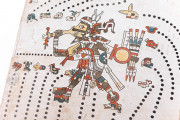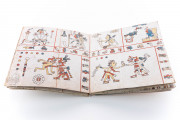The Codex Fejérváry-Mayer is a screenfold manuscript employing pictographs (picture writing) to guide the user in divination and religious rituals. Rather than being composed of folded sheets sewn at the spine, the "codex" is a four-meter-long strip of leather, probably deerskin, folded accordion-style into twenty-three panels. Made in central Mexico probably in the early sixteenth century, the Codex Fejérváry-Mayer is a handbook for indigenous religious practitioners.
The content is presented from right to left, with twenty-two panels painted on the obverse and twenty-two on the reverse. The first and last panels are painted only on one side, with the unpainted sides intended to receive hard covers. The manuscript is justly famous for its opening temporal and spiritual diagram of the cosmos (p. 1) and its closing pictograph of an almanac arranged around the figure of Tezcatlipoca, the deity of divination and rulership (p. 44)
The panels of the Codex Fejérváry-Mayer measure 17.5 × 17.5 cm. Most of the pages are devoted to almanacs to aid in prognostications concerning birth, marriage, animal attack, travel, and the planting of maize. The almanacs are supplemented by protocols for religious rituals involving bundled offerings.
Core Member of the Borgia Group
The Codex Fejérváry-Mayer is one of the Borgia Group of sacred manuals in the form of screenfolds, named for the Codex Borgia and which includes the Codex Cospi and the Codex Vaticanus B. The Codex Laud, also a member of the group, is particularly close stylistically to Fejérváry-Mayer.
Confluence of Artistic Traditions
The Codex Fejérváry-Mayer—like its stylistic twin, the Codex Laud—shows artistic influences from the Nahua and the Mixtec peoples, as well as from the tropical Gulf Coast of Mexico. Its pigments are derived from vegetal, insect, and mineral sources. The palette is dominated by red, yellow, and blue. The figures that compose the pictographs are outlined in black filled with areas of color, some with fine geometric patterns representing textures.
The Mesoamerican Cosmos
The first image encountered when opening the Codex Fejérváry-Mayer is a cosmogram of the Mesoamerican world. Each arm of a cross-shaped motif is painted a color representing one of the cardinal points of the compass: red is east, yellow is north, blue is west, and green is south. In the center of the motif is an image of Xiuhtecuhtli, one of the night lords. The other night lords appear in pairs at the east, north, west, and south of the cosmos. Read counterclockwise starting with the crocodile, the diagram moves through the 260 days of the calendar, with the days symbolized by animals and objects. The composition is similar to one found in the Maya Codex Madrid.
An Emphasis on Traveling
The remaining pages of the obverse are occupied by images of the nine lords of the night participating in rituals and prognostications using bundles of counted objects. The reverse of the codex comprises fifteen almanacs featuring deities collaborating with each other, seated in temples, or making offerings. Among these images are six walking figures representing travelers or merchants (pp. 30-32, upper register) identifiable by the burdens on their backs and their walking sticks.
A Concluding Cosmological Diagram
The Codex Fejérváry-Mayer ends with an ornate, full-page portrait of the striding god Tezcatlipoca encircled by twenty-day signs that are positioned around the deity’s body (p. 44). Like the cosmogram on p. 1, this composition fuses the temporal with the spiritual.
Named for Two Previous Owners
The screenfold is known to have been in the collection of Gabór Fejérváry (1780-1851), a Hungarian book and antiquities collector, whose nephew sold it in 1855 to the antiquary Joseph Mayer (1803–1886) of Liverpool. In 1867 Mayer donated his collection to the Free Public Museum of Liverpool, now the World Museum.
We have 1 facsimile edition of the manuscript "Codex Fejérváry-Mayer": Codex Fejérváry-Mayer facsimile edition, published by Akademische Druck- u. Verlagsanstalt (ADEVA), 1971
Request Info / Price

























